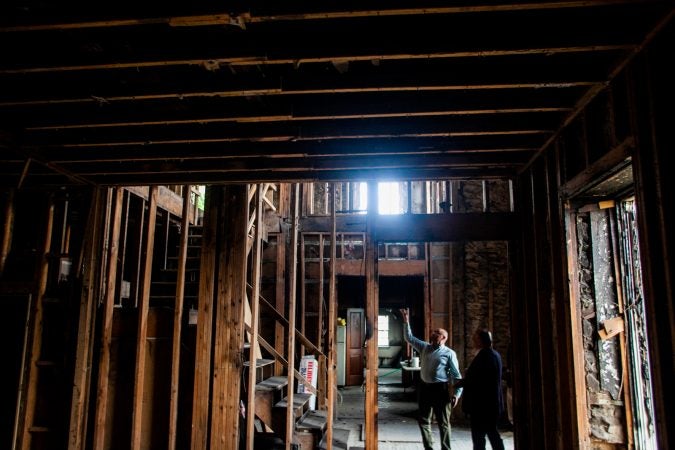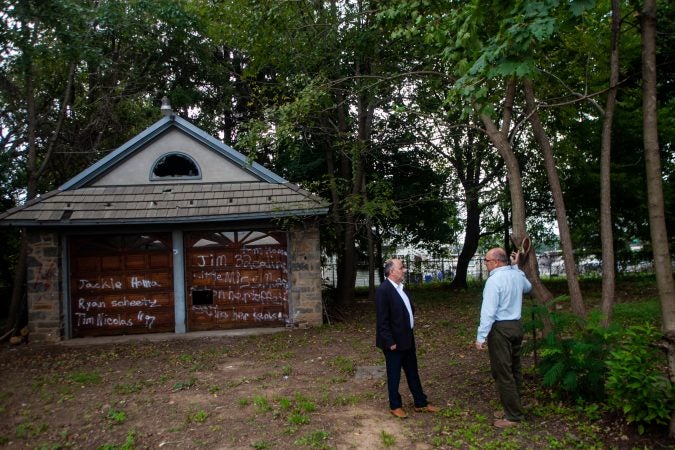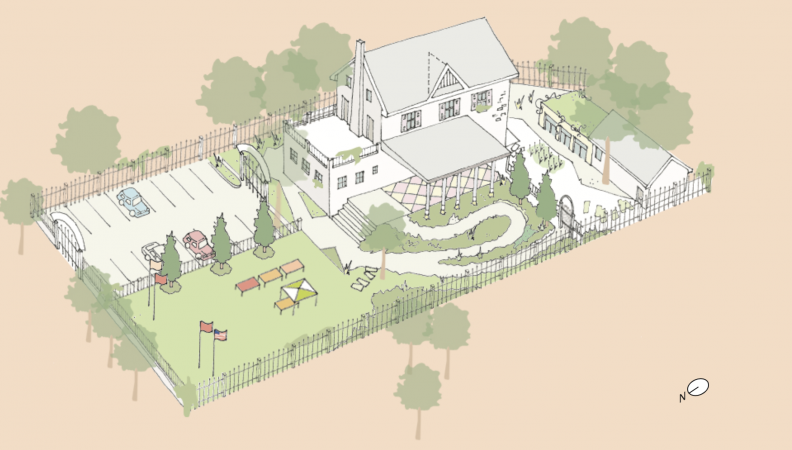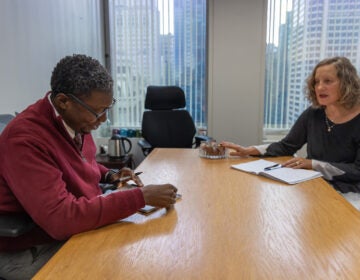A NE Philly school designed by a friend of Ben Franklin to be reborn as Albanian cultural center
It was a schoolhouse where Revolutionary-era leaders offered a "polite education" to young men in the then-new city of Philadelphia
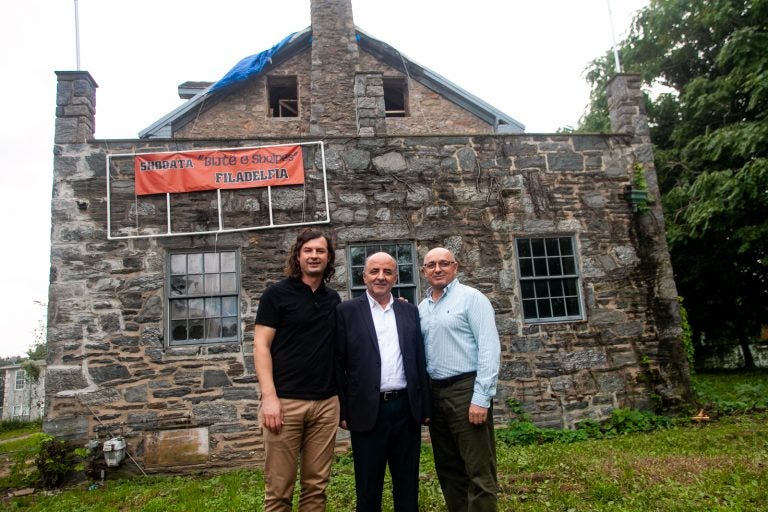
Lead architect Lluka Lakuriqi, left, Tajar Domi, center and Bujar Gjoka of the Albanian American Association are seen outside of the historic Lower Dublin Academy in Northeast Philadelphia. (Brad Larrison for WHYY)
This article originally appeared on PlanPhilly.
—
It was a schoolhouse where Revolutionary-era leaders offered a “polite education” to young men in the then-new city of Philadelphia, but by 2006, the Lower Dublin Academy was empty and crumbling. Now after 12 years of sitting vacant, the Holmesburg landmark will be a school again.
This time, the students will be Albanian children and new emigres learning not only about their Albanian heritage but also the history of their adopted home.
“We wanted to purchase this building not only to preserve our heritage and culture but also to help absorb the Albanian community into American culture,” said architect Luka Lakuriqi, a member of the Bijte e Shqipes Association that has purchased the historic landmark. “This building, because it has such a deep history, we thought would be the best way to teach and to help our community assimilate.”
Built in 1803, the schist fieldstone structure also resembles school buildings in Albania, with similar layout and structure, said Dritan Matraku, vice president of the group and a respiratory therapist at Children’s Hospital of Philadelphia. “So it is a very good connection to our culture.”
The 400-member cultural organization bought the building in July, a rescue for a structure that had become a target for vandals. The organization needed $200,000 to buy the property and in three months, they collected $140,000 from its members.
“That was the best thing because that told us the future and the support we were going to have,” said organization treasurer Bujar Gjoka, a planning administrator at a vitamin company.
The new owners estimate it will cost another $250,000 to complete restoration of the building.
But the project will be a “community engagement,” said Lakuriqi, who has designed plans for the project. The Bijte e Shqipes Association includes a variety of licensed contractors, business people and volunteers who will be involved in the building rehab. “Some are contributing money, some are contributing time, some are contributing their workers for a few days. It’s a real community effort,” he said.
Full Circle
The Lower Dublin Academy was designed and founded by Edward Duffield, a watchmaker, engraver, and ally of Ben Franklin. Duffield named the two-story structure Lower Dublin Academy, after the name of the area at the time. The land, which previously had hosted an 18-century log schoolhouse, had been deeded to Thomas Holme by William Penn, as partial payment to Holme for his service as surveyor-general and for creating the street plan for the newborn city of Philadelphia. In 1901, the building was purchased by the Board of Education and renamed the Thomas Holme School.
Then the history got a bit darker. In the 1940s, the building, located at Academy and Willits Roads, became a private residence owned by the Roedell family. In 1990, Dr. George Roedell got into an argument with his 32-year-old daughter about selling the building, and he shot her to death.
Roedell’s wife sold the building and property to a developer, who built the surrounding residential units, the Courtyard of Thomas Holme. The former Academy was purchased by an attorney, Richard Gutman, and his law partner, who had planned to move their offices there. The lawyers spent over $1 million to rehab the interior, but when their partnership ended, the plan for the building did, too.
In 2006, a fire caused extensive damage to the roof and interior, and the building has been vacant ever since.
But while the building was empty, it wasn’t forgotten. In 2014, it was nominated to the Philadelphia Register of Historic Places, only to be rejected by the Historical Commission, which deemed the nomination incomplete. In 2016, a second nomination came from Joe Menkevich, a retired welder-turned-historic researcher and 11 co-authors. The nomination was 108 pages long, with a history of the site, archival images and news clippings, aerial views, and biographies of the builder and related historical figures. The Historical Commission unanimously approved it.
Menkevich sees an element of “predestination” in the story of the Lower Dublin Academy.
“The school was built by Revolutionary War veterans and immigrants from Europe who were skilled tradesmen and is now in the hands of a new generation of American immigrants, also skilled tradesman from Europe. Given enough time, all things come full circle,” Menkevich said.
For the past 14 years, the Bijte e Shqipes Association has worked out of a building at Harbison and Torresdale Avenues. The location serves its 400 members and includes a school for 60 students who go there on Sundays to learn about their heritage. But there are about 32,000 Albanians in the Philadelphia area, and the numbers are growing by about 1,000 annually, the group estimates. The expanding organization needs a place with room to grow.
“There is a large influx of Albanian immigrants into Philadelphia, and we are hoping that the LDA will offer us the room needed to grow over the next 20 to 50 years,” Tajar Domi, president of the Albanian group and a substitute teacher in the Philadelphia school system.
The Northeast, Port Richmond, Fishtown, and the nearby suburban counties have become a popular settling place for Albanians, so when the organization learned about the availability of the Lower Dublin Academy, they acted. Its location just off I-95 yet set back from Academy Road and surrounded by trees seemed ideal.
The building’s story was also very appealing. “Every community is proud of its history and culture,” said Domi. “We Albanians are proud, too, of our history,” and when they learned they could purchase the Lower Dublin Academy, “we were prouder because this building has a lot of history of Philadelphia.”

Preserving “a sacred building”
Aside from the costs of buying and restoring the property, the organization also had to overcome the concerns of the preservation community.
“Everybody was very emotionally attached to this building,” Lakuriqi said. For local historians and preservations, “it is a sacred building, and we had to explain our intention. But the organization was able to convince every city agency, the Historical Commission, City Council, and local civic associations that we were the right party for this building.”
The organization will preserve the historic exterior of the building and all the remaining structure, which has survived in stable condition despite fire damage to the roof and interior and its years of vacancy.

“We’re definitely happy to see this property come back into productive use,” said Patrick Grossi, director of advocacy at the Preservation Alliance for Greater Philadelphia. “Many local stakeholders have worked long and hard to make that possible. We hope it can serve as another powerful example of the potential of historic properties.”
The Albanian organization hopes to open the building to the public in one year. The new school on the first floor will be able to accommodate 200 students. Other sections of the building will include a museum with exhibits on the history of the Albanian community and the history of the Lower Dublin Academy. The entire building will serve as a community center with a variety of activities for members and the surrounding neighborhoods.
“Anyone who wants to visit – and to help us – is more than welcome,” Domi said.
WHYY is your source for fact-based, in-depth journalism and information. As a nonprofit organization, we rely on financial support from readers like you. Please give today.



